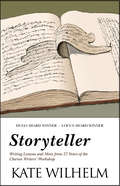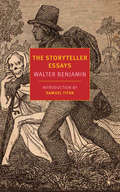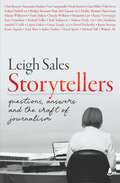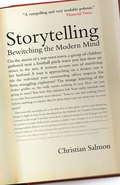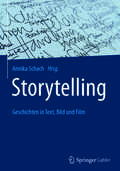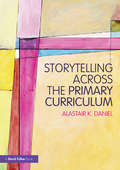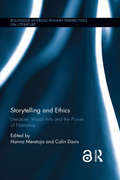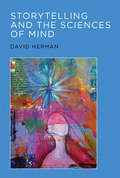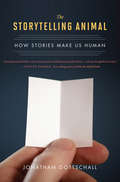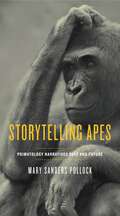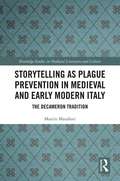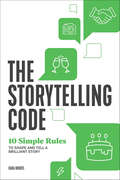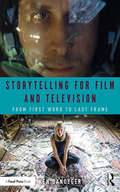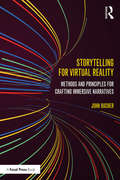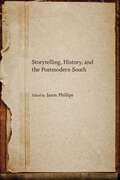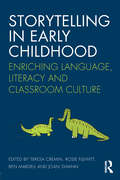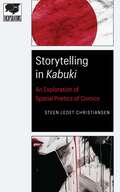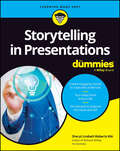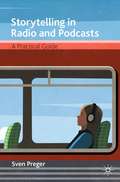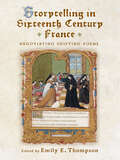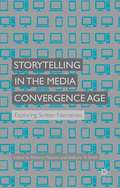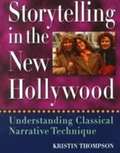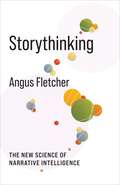- Table View
- List View
Storyteller: Writing Lessons and More from 27 Years of the Clarion Writers' Workshop
by Kate Wilhelm"Wilhelm really knows students and knows how to teach them to craft a professional story. "--The Oregonian Part memoir, part writing manual, Storyteller is an affectionate account of how the Clarion Writers' Workshop began, what Kate Wilhelm learned, and how she passed a love of the written word on to generations of writers. Includes writing exercises and advice. A Hugo and Locus award winner.
The Storyteller Essays
by Walter BenjaminA new translation of philosopher Walter Benjamin's work as it pertains to his famous essay, "The Storyteller," this collection includes short stories, book reviews, parables, and as a selection of writings by other authors who had an influence on Benjamin's work.“The Storyteller” is one of Walter Benjamin’s most important essays, a beautiful and suggestive meditation on the relation between narrative form, social life, and individual existence—and the product of at least a decade’s work. What might be called the story of The Storyteller Essays starts in 1926, with a piece Benjamin wrote about the German romantic Johann Peter Hebel. It continues in a series of short essays, book reviews, short stories, parables, and even radio shows for children. This collection brings them all together to give readers a new appreciation of how Benjamin’s thinking changed and ripened over time, while including several key readings of his own—texts by his contemporaries Ernst Bloch and Georg Lukács; by Paul Valéry; and by Herodotus and Montaigne. Finally, to bring things around, there are three short stories by “the incomparable Hebel” with whom the whole intellectual adventure began.
Storytellers: Questions, Answers and the Craft of Journalism
by Leigh SalesHighly respected ABC anchor, bestselling author and hit podcaster Leigh Sales interviews the cream of Australian journalists about their craft – how (and why) they bring us the stories that inform our lives. Leigh Sales is one of Australia&’s most accomplished journalists, having anchored the ABC&’s flagship 7.30 program for twelve years. She has been a foreign correspondent, hosted Lateline and anchored numerous elections for the ABC. In this book, she turns her interviewing skills onto her own profession, those usually asking the questions: the journalists. In ten sections – from News Reporting to Editing, via Investigative, Commentary and of course Interviewing – Sales takes us on a tour of the profession, letting the leaders in their field talk direct to us about how they get their leads, survive in war zones, write a profile, tell a story with pictures, and keep the show on the road. A who&’s-who of Australian journalism – including Lisa Millar, Kate McClymont, Hedley Thomas, Trent Dalton, Benjamin Law, Tracy Grimshaw, Richard Fidler, David Speers, Stan Grant, Niki Savva, Waleed Aly, Annabel Crabb, Karl Stefanovic and Mia Freedman – talk candidly about their greatest lessons and their trade secrets. A fascinating insight into a vital and much-misunderstood profession, Storytellers is a book for anyone who&’s ever wanted to be a journalist, or even just wondered how the news gets made.
Storytelling: Bewitching the Modern Mind
by Christian SalmonPolitics, as currently practiced, is no longer the art of the possible, but the art of the fictive. Its aim is not to change the world as it exists, but to affect the way it is perceived. This is the subject of Christian Salmon's Storytelling, which looks at how the creative imagination has been hijacked in the twenty-first century. Salmon anatomizes the timeless human desire for narrative form and how it is abused in the marketing mechanisms behind politicians and products: luxury brands trade on their embellished histories, managers tell stories to motivate employees, soldiers in Iraq train on computer games conceived in Hollywood, and spin doctors construct political lives as if they were a folk epic. Salmon unveils the workings of a "storytelling machine" more effective and insidious as a means of oppression than anything dreamed up by Orwell. The "reality-based community"--to use a phrase coined by an aide to George W. Bush--is now regularly outmaneuvered by public relations gurus and political advisers, as they construct story arcs for a population that has come to expect them.
Storytelling
by Annika SchachDas Buch pr#65533;sentiert eine textlinguistische Analyse von Texten zur Unternehmensgeschichte und widmet sich dem vielzitierten Storytelling-Trend. Anhand von Textexemplaren der DAX30-Unternehmen werden die Textfunktion, Themenentfaltung und Formulierungsspezifika untersucht. Ein besonderer Schwerpunkt liegt in der Fragestellung, inwieweit Narration als Vertextungsstrategie verwendet wird und wie sich die Textexemplare in einer Typologie beschreiben lassen. Die Arbeit stellt zudem einen Bezug zum medienwissenschaftlichen Framing-Ansatz her.
Storytelling across the Primary Curriculum
by Alastair K DanielStarting from the question ‘what is a story?’ Storytelling Across the Primary Curriculum leads the reader through the theory and practise of storytelling as an educational method – a method taught by the author over the last ten years through Primary English teaching programmes. This practical book gives teachers the skills and confidence to use storytelling and the spoken word in new and exciting ways in the classroom. It will also give teachers the confidence to ‘put down the book’ and trust themselves to tell, rather than read, a story. It provides a wealth of examples of cross-curricular teaching opportunities, including a section on the ways in which the teaching of phonics can be embedded in the 'real' language of story. Storytelling Across the Primary Curriculum is ideal for trainee and practicing primary school teachers who want to develop their classroom practice within the field of storytelling. Students on BA Primary, BEd, and PGCE courses, particularly those specialising in English, will also benefit from this book’s stimulating and intuitive approach to teaching English language and literacy.
Storytelling and Ethics: Literature, Visual Arts and the Power of Narrative (Routledge Interdisciplinary Perspectives on Literature)
by Colin Davis Hanna MeretojaIn recent years there has been a huge amount of both popular and academic interest in storytelling as something that is an essential part of not only literature and art but also our everyday lives as well as our dreams, fantasies, aspirations, historical self-understanding, and political actions. The question of the ethics of storytelling always, inevitably, lurks behind these discussions, though most frequently it remains implicit rather than explicit. This volume explores the ethical potential and risks of storytelling from an interdisciplinary perspective. It stages a dialogue between contemporary literature and visual arts across media (film, photography, performative arts), interdisciplinary theoretical perspectives (debates in narrative studies, trauma studies, cultural memory studies, ethical criticism), and history (traumatic histories of violence, cultural history). The collection analyses ethical issues involved in different strategies employed in literature and art to narrate experiences that resist telling and imagining, such as traumatic historical events, including war and political conflicts. The chapters explore the multiple ways in which the ethics of storytelling relates to the contemporary arts as they work with, draw on, and contribute to historical imagination. The book foregrounds the connection between remembering and imagining and explores the ambiguous role of narrative in the configuration of selves, communities, and the relation to the non-human. While discussing the ethical aspects of storytelling, it also reflects on the relevance of artistic storytelling practices for our understanding of ethics. Making an original contribution to interdisciplinary narrative studies and narrative ethics, this book both articulates a complex understanding of how artistic storytelling practices enable critical distance from culturally dominant narrative practices, and analyzes the limitations and potential pitfalls of storytelling.
Storytelling and the Sciences of Mind
by David HermanAn transdisciplinary exploration of narrative not just as a target for interpretation but also as a means for making sense of experience itself.With Storytelling and the Sciences of Mind, David Herman proposes a cross-fertilization between the study of narrative and research on intelligent behavior. This cross-fertilization goes beyond the simple importing of ideas from the sciences of mind into scholarship on narrative and instead aims for convergence between work in narrative studies and research in the cognitive sciences. The book as a whole centers on two questions: How do people make sense of stories? And: How do people use stories to make sense of the world? Examining narratives from different periods and across multiple media and genres, Herman shows how traditions of narrative research can help shape ways of formulating and addressing questions about intelligent activity, and vice versa.Using case studies that range from Robert Louis Stevenson's Dr Jekyll and Mr Hyde to sequences from The Incredible Hulk comics to narratives told in everyday interaction, Herman considers storytelling both as a target for interpretation and as a resource for making sense of experience itself. In doing so, he puts ideas from narrative scholarship into dialogue with such fields as psycholinguistics, philosophy of mind, and cognitive, social, and ecological psychology. After exploring ways in which interpreters of stories can use textual cues to build narrative worlds, or storyworlds, Herman investigates how this process of narrative worldmaking in turn supports efforts to understand—and engage with—the conduct of persons, among other aspects of lived experience.
The Storytelling Animal: How Stories Make Us Human
by Jonathan Gottschall&“Insightful...draws from disparate corners of history and science to celebrate our compulsion to storify everything around us.&”—The New York Times Book Review Humans live in landscapes of make-believe. We spin fantasies. We devour novels, films, and plays. Even sporting events and criminal trials unfold as narratives. Yet the world of story has remained an undiscovered and unmapped country. It&’s easy to say that humans are &“wired&” for story, but why? In this delightful, original book, Jonathan Gottschall offers the first unified theory of storytelling. He argues that stories help us navigate life&’s complex social problems—just as flight simulators prepare pilots for difficult situations. Storytelling has evolved, like other behaviors, to ensure our survival. Drawing on the latest research in neuroscience, psychology, and evolutionary biology, Gottschall tells us what it means to be a storytelling animal. Did you know that the more absorbed you are in a story, the more it changes your behavior? That all children act out the same kinds of stories, whether they grow up in a slum or a suburb? That people who read more fiction are more empathetic? Of course, our story instinct has a darker side. It makes us vulnerable to conspiracy theories, advertisements, and narratives about ourselves that are more &“truthy&” than true. National myths can also be terribly dangerous: Hitler&’s ambitions were partly fueled by a story. But as Gottschall shows, stories can also powerfully change the world for the better. We know we are master shapers of story. The Storytelling Animal finally reveals how stories shape us. &“Lively.&”—San Francisco Chronicle &“Absorbing.&”—Minneapolis Star Tribune &“One of my favorite evolutionary psych writers—always insightful and witty.&”—Steven Pinker
Storytelling Apes: Primatology Narratives Past and Future (Animalibus: Of Animals and Cultures #5)
by Mary Sanders PollockThe annals of field primatology are filled with stories about charismatic animals native to some of the most challenging and remote areas on earth. There are, for example, the chimpanzees of Tanzania, whose social and family interactions Jane Goodall has studied for decades; the mountain gorillas of the Virungas, chronicled first by George Schaller and then later, more obsessively, by Dian Fossey; various species of monkeys (Indian langurs, Kenyan baboons, and Brazilian spider monkeys) studied by Sarah Hrdy, Shirley Strum, Robert Sapolsky, Barbara Smuts, and Karen Strier; and finally the orangutans of the Bornean woodlands, whom Biruté Galdikas has observed passionately. Humans are, after all, storytelling apes. The narrative urge is encoded in our DNA, along with large brains, nimble fingers, and color vision, traits we share with lemurs, monkeys, and apes. In Storytelling Apes, Mary Sanders Pollock traces the development and evolution of primatology field narratives while reflecting upon the development of the discipline and the changing conditions within natural primate habitat. Like almost every other field primatologist who followed her, Jane Goodall recognized the individuality of her study animals: defying formal scientific protocols, she named her chimpanzee subjects instead of numbering them, thereby establishing a trend. For Goodall, Fossey, Sapolsky, and numerous other scientists whose works are discussed in Storytelling Apes, free-living primates became fully realized characters in romances, tragedies, comedies, and never-ending soap operas. With this work, Pollock shows readers with a humanist perspective that science writing can have remarkable literary value, encourages scientists to share their passions with the general public, and inspires the conservation community.
Storytelling Apes: Primatology Narratives Past and Future (Animalibus)
by Mary Sanders PollockThe annals of field primatology are filled with stories about charismatic animals native to some of the most challenging and remote areas on earth. There are, for example, the chimpanzees of Tanzania, whose social and family interactions Jane Goodall has studied for decades; the mountain gorillas of the Virungas, chronicled first by George Schaller and then later, more obsessively, by Dian Fossey; various species of monkeys (Indian langurs, Kenyan baboons, and Brazilian spider monkeys) studied by Sarah Hrdy, Shirley Strum, Robert Sapolsky, Barbara Smuts, and Karen Strier; and finally the orangutans of the Bornean woodlands, whom Biruté Galdikas has observed passionately. Humans are, after all, storytelling apes. The narrative urge is encoded in our DNA, along with large brains, nimble fingers, and color vision, traits we share with lemurs, monkeys, and apes. In Storytelling Apes, Mary Sanders Pollock traces the development and evolution of primatology field narratives while reflecting upon the development of the discipline and the changing conditions within natural primate habitat. Like almost every other field primatologist who followed her, Jane Goodall recognized the individuality of her study animals: defying formal scientific protocols, she named her chimpanzee subjects instead of numbering them, thereby establishing a trend. For Goodall, Fossey, Sapolsky, and numerous other scientists whose works are discussed in Storytelling Apes, free-living primates became fully realized characters in romances, tragedies, comedies, and never-ending soap operas. With this work, Pollock shows readers with a humanist perspective that science writing can have remarkable literary value, encourages scientists to share their passions with the general public, and inspires the conservation community.
Storytelling as Plague Prevention in Medieval and Early Modern Italy: The Decameron Tradition
by Martin MarafiotiThrough close readings of five Italian collections of novellas written over a 500-year period, Martin Marafioti explores the literary tradition of storytelling, and particularly its efficacy as a healing tool following traumatic visitations from the plague. In this study, Giovanni Boccaccio's Decameron provides the framework for later authors. Although Boccaccio was not the first writer to deal with pestilence or epidemics in a literary work, he was the first to unite the topos of a life-threatening context with a public health disaster like the Black Death, and certainly the first author to propose storytelling as a means of prophylaxis in times of plague. Marafioti goes on to analyze Franco Sacchetti's Trecento Novelle, Giovanni Sercambi's Novelliere, Celio Malespini's Duecento Novelle, and Francesco Argelati's Decamerone, following in its longue-durée the ups and down, structurally and thematically, of the realistic novella as a genre.
The Storytelling Code: 10 Simple Rules to Shape and Tell a Brilliant Story
by Dana NorrisUnlock the tales within you—unleash the power of storytellingEveryone loves a good story—but how do you turn a fun anecdote into one for the books? Whether you're hoping to impress others during a job interview, trying out stand-up, or giving a hilarious wedding speech, The Storytelling Code provides step-by-step help on crafting your narrative, as well as simple exercises to put those public speaking skills into practice.Master the art of storytelling using 10 easy-to-follow rules to help you shape your story and share it confidently. Humorous advice will give you the courage to tell stories in your everyday life, and the unique exercises will demonstrate how to set a goal for each tale, gather the best materials, keep your audience engaged, and more.The Storytelling Code includes:Tell-tale heart—Release your inner storyteller using 10 easy-to-follow rules, including advice for identifying a narrative goal, shaping a plot, and more.Gift of gab—Find the confidence to go live through courage-building tips that make sure you're capturing and connecting with your audience.Pen to paper—Get those creative writing juices flowing with fill-in writing prompts and insightful checklists to prep you for everyday storytelling situations.Make every story mic drop-worthy with The Storytelling Code.
Storytelling for Film and Television: From First Word to Last Frame
by Ken DancygerStorytelling for Film and Television is a theory and practice book which offers a definitive introduction to the art of storytelling through writing, directing, and editing. Author Ken Dancyger provides a comprehensive explanation of the tools that underpin successful narrative filmmaking and television production. The book takes a unique approach by connecting the different phases of the creative process of film and television production. It shows how writing, directing, and editing all contribute to the process of storytelling and function together to advance the narrative goals of a screenplay, to tell the best story. A case study approach provides numerous examples of effectiveness and brings together the core areas of aesthetics and production to make these concepts more accessible. Case studies include classic and modern films, foreign films, limited and series television, with examples including Breaking Bad, Game of Thrones, The Revenant, and Son of Saul. This is the ideal text for film and television production students at all levels. It is written in a style which makes it accessible to anybody interested in learning more about the storytelling process and is written for a global audience addressing a global industry.
Storytelling for Virtual Reality: Methods and Principles for Crafting Immersive Narratives
by John BucherStorytelling for Virtual Reality serves as a bridge between students of new media and professionals working between the emerging world of VR technology and the art form of classical storytelling. Rather than examining purely the technical, the text focuses on the narrative and how stories can best be structured, created, and then told in virtual immersive spaces. Author John Bucher examines the timeless principles of storytelling and how they are being applied, transformed, and transcended in Virtual Reality. Interviews, conversations, and case studies with both pioneers and innovators in VR storytelling are featured, including industry leaders at LucasFilm, 20th Century Fox, Oculus, Insomniac Games, and Google. For more information about story, Virtual Reality, this book, and its author, please visit StorytellingforVR.com
Storytelling, History, and the Postmodern South: The Life of a Soldier of Fortune (Southern Literary Studies)
by Jason PhillipsIn this innovative collection, Jason Phillips and ten other historians and literary scholars explore the enduring dynamic between history, literature, and power in the American South. Blending analysis with storytelling, and professional insights with personal experiences, they "deconstruct Dixie," insisting that writing the South's history means harnessing, not criticizing, the inherent power of narrative.Contributors examine white southern texts from multiple, fresh perspectives and consider ways in which storytelling helped shape identity and mold scholarship over time. Bertram Wyatt-Brown argues that William Percy's life and work blurred fact and fiction to reconcile the anti-intellectual conventions of a rural, hierarchical South with his cosmopolitan mindset. Orville Vernon Burton and Ian Binnington investigate nationalism, local allegiances, and the imagined community of the Confederacy. Farrell O'Gorman, Jewel L. Spangler, David A. Davis, Robert Jackson, Anne Marshall, K. Stephen Prince, and Jim Downs explore diverse topics such as southern Gothic fiction and the centrality of religion, white trash autobiographies, the "professional southerner" in literature and criticism, and the "one-drop rule" of racial taxonomy in America. These writers look beyond ideology and race, showcasing new ways of interpreting texts and encouraging scholars to move beyond theory to engage the historical context of southern stories and storytelling.
Storytelling in Early Childhood: Enriching language, literacy and classroom culture
by Teresa Cremin, Rosie Flewitt, Ben Mardell and Joan SwannStorytelling in Early Childhood is a captivating book which explores the multiple dimensions of storytelling and story acting and shows how they enrich language and literacy learning in the early years. Foregrounding the power of children’s own stories in the early and primary years, it provides evidence that storytelling and story acting, a pedagogic approach first developed by Vivian Gussin Paley, affords rich opportunities to foster learning within a play-based and language-rich curriculum. The book explores a number of themes and topics, including: the role of imaginary play and its dynamic relationship to narrative; how socially situated symbolic actions enrich the emotional, cognitive and social development of children; how the interrelated practices of storytelling and dramatisation enhance language and literacy learning, and contribute to an inclusive classroom culture; the challenges practitioners face in aligning their understanding of child literacy and learning with a narrow, mandated curriculum which focuses on measurable outcomes. Driven by an international approach and based on new empirical studies, this volume further advances the field, offering new theoretical and practical analyses of storytelling and story acting from complementary disciplinary perspectives. This book is a potent and engaging read for anyone intrigued by Paley’s storytelling and story acting curriculum, as well as those practitioners and students with a vested interest in early years literacy and language learning. With contributions from Vivian Gussin Paley, Patricia ‘Patsy‘ Cooper, Dorothy Faulkner, Natalia Kucirkova, Gillian Dowley McNamee and Ageliki Nicolopoulou.
Storytelling in Kabuki: An Exploration of Spatial Poetics of Comics (Encapsulations: Critical Comics Studies)
by Steen Ledet ChristiansenSteen Ledet Christiansen&’s Storytelling in &“Kabuki&” explores the series created by David Mack—a slow, recursive narrative that focuses on the death of Kabuki and her past. The series ran from 1994 to 2004 in a variety of miniseries, one-shots, and spin-offs, rather than following a conventional American monthly release schedule. Most of the series explores different perspectives on the same event and adds background to Kabuki&’s past, usually through surreal sequences, dreams, and near-death experiences. The flexibility of comics&’ approach to chronology, space, focalization, narrative, and fictionality enabled Mack to produce an unusual experience. Kabuki tells a story that can only exist via comics. Christiansen analyzes the visual design of the series, a heterogeneous collection of styles depending on the story. To understand Kabuki, it is crucial to explore the visual styles, as well as the use of visual and spatial rhymes and mixed media forms. Because Kabuki employs a complex layering of focalizations, diegetic levels, and metafictional self-reflectivity that is rare in mainstream American comics, it utilizes a narrative poetics that focuses on constant repeating, restating, and returning to the same events.Kabuki&’s unique compositional layering allows Christiansen to provide a clear example of how comics work while also expanding on critical vocabulary, especially in terms of spatial poetics. By exploring spatial form, Christiansen illuminates and gives a critical framework to a different and underexamined aspect of comics.
Storytelling in Northern Zambia
by Robert CancelMore than just a book, Storytelling in Northern Zambia lets you watch videos of the storytellers while you read. Storytelling plays an important part in the vibrant cultural life of Zambia and in many other communities across Africa. This innovative book provides a collection and analysis of oral narrative traditions as practiced by five Bemba-speaking ethnic groups in Zambia. The integration of newly digitalised audio and video recordings into the text enables the reader to encounter the storytellers themselves and hear their narratives as they were recounted during Robert Cancel’s research trips to Zambia. Robert Cancel's thorough critical interpretation, combined with these newly digitalised audio and video materials, makes Storytelling in Northern Zambia a much needed addition to the slender corpus of African folklore studies that deal with storytelling performance. Cancel threads his way between the complex demands of African fieldwork studies, folklore theory, narrative modes, reflexive description and simple documentation and succeeds in bringing to the reader a set of performers and their performances that are vivid, varied and instructive. He illustrates this living narrative tradition with a wide range of examples, and highlights the social status of narrators and the complex local identities that are at play. Cancel’s innovative study tells us not only about storytelling but sheds light on the study of oral literatures throughout Africa and beyond. Its innovative format, meanwhile, explores new directions in the integration of primary source material into scholarly texts. This book is part of our World Oral Literature Series in conjunction with the World Oral Literature Project.
Storytelling in Presentations For Dummies
by Sheryl Lindsell-RobertsLearn to influence audiences with storyopia: Stories that take them on a journey from what is to what could be: Storytelling in Presentations For Dummies shows you how to develop and deliver a presentation through storytelling, keeping audience interested, and most importantly, making them heroes that take action towards change. You’ll learn how to cull stories from your own experiences, and before you know it, you’ll have more stories than Aesop has fables. You’ll learn about the latest presentation software, so you can integrate visuals into your presentations and avoid the dreaded “Death by PowerPoint.” You’ll also learn how to deal with challenging on-the-spot situations, deliver investor pitches and executive briefs, and present a paper at a conference. Additionally, find out how to deliver someone else’s content and make it your own. This book will help you level up anywhere you need to present information by mastering the art of savvy presentations—the most effective business communications tools of our time. Identify experiences that can be molded into stories that drive change. Prepare powerful openings to hook your audience right away whether delivering in person, online, or hybrid Have your audience get the most from your presentation with an effective call to action Prepare a storyboard, which is like a frame-by-frame roadmap, that will mesh together what you’ll show and what you’ll tell Leverage software like Canva, Prezi, and Storyboarder to tie your presentation together Enjoy the colorful 8-page mini-booklet, “Storytelling to Storyboarding”This Dummies guide is perfect for any professional who needs to present, and at some time all professionals do. It’s also for entrepreneurs who want to build community and grow their business, in addition to students who want to wow teachers and classmates.
Storytelling in Radio and Podcasts: A Practical Guide
by Sven PregerThis textbook offers a practical guide to creating narratives in audio media. It is one of the most beautiful and complex tasks in radio and podcasting: how do you tell a compelling story and keep your listeners tuned in? In Storytelling in Radio and Podcasts, Preger offers practical answers to crucial questions: What material is suitable for long stories? How can I bind listeners to a real story for 15, 30 or 60 minutes? Or even get them excited about a whole series? How do I maintain suspense from beginning to end? How do I find my narrative voice? And, how do I develop a sound design for complex narratives? Richly illustrated using practical examples, the book guides the reader through various stages of developing a non-fiction narrative and examines structure, character development, suspense, narration, sound-design and ethics.
Storytelling in Sixteenth-Century France: Negotiating Shifting Forms (The Early Modern Exchange)
by JoAnn DellaNeva Sheila Ffolliott Amy Graves Monroe David LaGuardia Kathleen Loysen Dora E. Polachek Marian Rothstein Emily E. Thompson Phillip John Usher Colette H. Winn Cathy YandellStorytelling in Sixteenth-Century France is an innovative, interdisciplinary examination of parallels between the early modern era and the world in which we live today. Readers are invited to look to the past to see how then, as now, people turned to storytelling to integrate and adapt to rapid social change, to reinforce or restructure community, to sell new ideas, and to refashion the past. This collection explores different modalities of storytelling in sixteenth-century France and emphasizes shared techniques and themes rather than attempting to define narrow kinds of narrative categories. Through studies of storytelling in tapestries, stone, and music as well as distinct genres of historical, professional, and literary writing (addressing both erudite and more common readers), the contributors to this collection evoke a society in transition, wherein traditional techniques and materials were manipulated to express new realities. Published by the University of Delaware Press. Distributed worldwide by Rutgers University Press.
Storytelling in the Media Convergence Age
by Roberta Pearson Anthony N. SmithThis collection investigates the relationship between contemporary screen narratives and their varied contexts of production, circulation and reception, exploring storytelling practices across a range of different media and national and institutional sites. While convergence and globalisation blur the boundaries between media and nations, it is still vital to account for the persistent national, medium, institutional and technological specificities that give rise to different narrative forms. The chapters study the ways in which these factors shape events, characters and settings; inform modes of narrative presentation; influence, via paratextual surround, potential interpretations; and accord certain stories more value than others. The authors use case studies drawn from a range of media, from Hollywood franchises to digital comics, and a range of countries, from United States to Japan. In connecting contemporary screen media narratives to their contexts, this book offers a new perspective on recent transformations in screen media culture.
Storytelling in the New Hollywood: Understanding Classical Narrative Technique
by Kristin ThompsonKristin Thompson offers the first in-depth analysis of Hollywood's storytelling techniques and how they are used to make complex, easily comprehensible, entertaining films.
Storythinking: The New Science of Narrative Intelligence (No Limits)
by Angus FletcherEvery time we think ahead, we are crafting a story. Every daily plan—and every political vision, social movement, scientific hypothesis, business proposal, and technological breakthrough—starts with “what if?” Linking causes to effects, considering hypotheticals and counterfactuals, asking how other people will react: these are the essence of narrative. So why do we keep overlooking story’s importance to intelligence in favor of logic?This book explains how and why our brains think in stories. Angus Fletcher, an expert in neuroscientific approaches to narrative, identifies this capacity as “storythinking.” He demonstrates that storythinking is fundamental to what makes us human. Artificial intelligence can perform symbolic logic, rational deduction, and mathematical calculation, but it is incapable of deliberating in narrative. Drawing on new research in neuroscience and narrative theory, Fletcher explores the nature of imagination, innovation, and creativity. He provides concise answers to big questions: How does storythinking work? Why did it evolve? How can it misfire? What problems can it solve?Revealing the significance of storythinking from science to business to philosophy, this book also provides ways for readers to harness its power to script better tomorrows.
